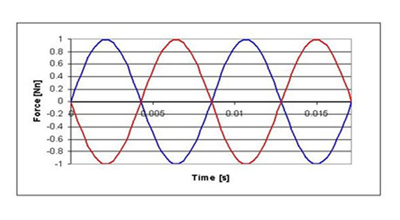
In the past, attempts to reduce the effects of noise and vibration in vehicles have been based on passive technology and the use of elastomeric springs for isolation. However, Trelleborg’s anti-vibration experts have now developed an innovative noise reduction system that uses active force cancellation, sparking considerable interest among the world’s major automobile manufacturers.
The active force cancellation system uses special actuators located near mount attachment points to generate waves at the same frequency and amplitude as those created by noise and vibrations. When transmitted completely out of phase, the waves cancel each other out.
“It sounds simple, but we have been working on it for more than a decade,†says Manfred Hofmann, technical director at Trelleborg Automotive’s Technical Center in Höhr-Grenzhausen, Germany.
Now Trelleborg is talking to automotive manufacturers and offering the active force cancellation system as an alternative to the current use of balance shafts for noise reduction. “Use of balance shafts is quite expensive technology and it mainly works for higher RPMs, so we’re suggesting manufacturers opt for an active system instead, which offers wider performance,†says Manfred Hofmann.
The system is also perfectly suited to new and more environmentally-friendly engine configurations, explains Manfred Hofmann. “Manufacturers are looking to reduce emissions by introducing new engine configurations that switch off certain cylinders when the engine is not operating at maximum power.
Although this contributes to fuel economy, it creates more vibration and noise that our technology can reduce.â€
Trelleborg is also looking to target specific vehicles with particular noise reduction requirements. “Some vehicles, such as three-cylinder diesels, have greater need for such technology,†says Manfred Hofmann.
“Rather than being fitted as standard, active force cancellation systems could be ideal for those cars whose engines create more vibration than others,†he explains.
Another potential use for the technology was highlighted by recent inquiries from one major manufacturer who is currently examining a project to create the perfect engine sound to suit the car model.
“Rather than canceling it out, they want to tune the sound to create a desirable sound quality with specific harmonics,†says Manfred Hofmann.
For the cars of the future, there is still a role for active force cancellation to play, contends Manfred Hofmann. “With the industry looking to fuel-cell technology in the future, engines will make a lot less noise once the internal combustion is removed. However, there could still be problems with wind or other disturbing noises, which would be an ideal application for us to create a better driving experience.â€
Harmonic waves are key
Active force cancellation uses actuators to generate waves of the same frequency and amplitude as the disturbance force that are 180° out of phase with the original. The actuators are driven in a closed feed forward control loop, which means that multiple order harmonic waves are cancelled even when engine speeds change very quickly.













More Stories
Some Ways How Motorists End Up in Collisions at U-Turns
Maximise Margins with Proven PPF Tactics
Finding the Car Boot Release Button – Tips and Tricks